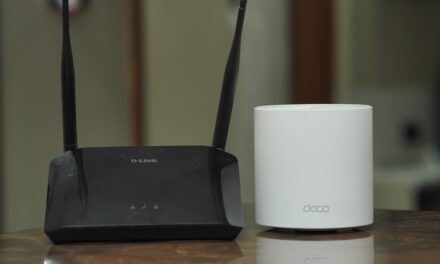
In today’s connected world, a reliable and expansive internet connection is essential. While a standalone router might seem sufficient, the advantages of a wireless mesh system for larger homes or offices are undeniable. This article explores why I transitioned from a traditional router to a mesh Wi-Fi setup, highlighting the limitations of standalone routers and the superior benefits of mesh technology.
Understanding Mesh Wi-Fi Systems
What is a Mesh Wi-Fi System?
A mesh router system is a game-changer, functioning as a team of devices that work together to provide strong, reliable WiFi throughout an entire office. Mesh WiFi represents a significant advancement, delivering seamless internet coverage for home networks, guest networks, and smart home applications. Unlike a traditional router, which often struggles with dead zones, a mesh system employs multiple satellite mesh nodes to broadcast the wifi signal across every corner of the home or office. Mesh WiFi networks are particularly beneficial for larger homes or complex layouts with numerous connected devices, with mesh wifi systems providing the best WiFi solution for seamless coverage.
Components of a Mesh Wi-Fi Network
A mesh Wi-Fi network comprises a main router connected to your modem and several satellite devices, commonly called mesh nodes. The wifi mesh networks include a main access point router connected to a modem, which in turn is connected to the internet. The WiFi signal is then broadcast to multiple mesh WiFi satellite nodes, which are strategically placed to provide the best possible internet connection upstairs, downstairs, and even outdoors, ensuring complete wifi coverage throughout the premises.
How Mesh Technology Differs from Traditional Routers
All mesh nodes in a mesh system broadcast the same network name (SSID) and password. The satellite mesh nodes communicate with an overlapping WiFi signal to form a single cohesive mesh network. Your devices automatically connect to the strongest mesh node signal, ensuring a seamless online experience as you move around. This is a significant improvement over traditional wifi, where devices often cling to a weaker signal from the main router even when a stronger signal from a WiFi extender is available. WiFi mesh System offers superior wifi performance compared to traditional router setups.
New home – single WiFi router or mesh?
The mesh wifi system architecture is particularly well-suited for modern offices with open floor plans, multiple levels, or signal-blocking materials like concrete and steel, where a standalone router might struggle. A traditional WiFi router can be a cost-effective choice for smaller, single-floor offices where coverage demands are straightforward. However, for a broader wifi range and more reliable wifi in a new home or office, use a mesh unit.
Benefits of Using Mesh Wi-Fi

Enhanced Coverage and Connectivity
A mesh system stands out by using multiple nodes to create a consistent web of Wi-Fi coverage, effectively eliminating dead zones in large areas. This is especially advantageous in homes or offices where a single router may struggle to provide adequate coverage. Mesh Wi-Fi addresses these challenges by delivering a seamless blanket of superfast wireless connection throughout the entire space, enhancing performance and ensuring a stable signal for all connected devices. Compared to traditional routers, mesh systems typically offer superior coverage. They also provide better network scalability and consistent performance, making them an ideal choice for environments with high connectivity demands.
Seamless Roaming and Network Management
IT teams can monitor and control the entire mesh network through a single, centralized dashboard. This simplifies network management and allows for easy configuration and troubleshooting, a significant advantage over managing multiple extenders or access points. In a mesh network, your devices intelligently switch to the mesh nodes with the strongest wifi signal as you move around. This transition is automatic and happens without interrupting your wifi connection, ensuring a seamless user experience. Mesh networks are easy to set up, manage, and optimise, making them user-friendly for both home users and IT professionals. A mesh wifi system simplifies the network so you can use wifi with ease.
Scalability of Mesh Systems
One of the key benefits of mesh wifi systems is their scalability. If you need to cover a larger area, you can simply add more nodes to the existing router to expand your network’s reach. This is a significant advantage over using a traditional router, which may require you to replace the entire router to improve wifi range. Expanding a mesh network is simple: you just add another node to the system. The new node integrates automatically, extending the unified mesh network without complicating management. This makes mesh wifi a future-proof solution that can adapt to changing connectivity needs. Instead of using a new router, you can expand an existing router to improve range.
Comparing Router Technologies

Traditional Router vs. Mesh Router
A traditional WiFi router is a single, standalone device that acts as the central hub for your internet connection. Unlike a mesh wifi system, which employs multiple mesh nodes for comprehensive coverage, a traditional or stand-alone router broadcasts the wifi signal from a single access point. The effective wifi range of a traditional wifi router may be limited by physical barriers or distance, leading to dead zones in larger homes or offices. If you’re struggling to get a strong wifi signal in certain areas, this is where the benefits of mesh become apparent. The simplicity of a single router can be appealing, but the performance limitations can be a significant drawback in environments requiring reliable wifi throughout.
Performance Differences: Mesh Wi-Fi vs. Standalone Router
Traditional routers come equipped with multiple Ethernet ports. If your business operates in a large, multi-story building or has a layout with signal-blocking materials, a mesh network will provide the consistent, reliable coverage you need. Traditional routers can get overwhelmed in high-demand scenarios, mesh networks intelligently manage home networks, guest networks, and smart home Internet of Things (IoT) applications. While a traditional router relies on a single broadcast point for its wifi signal, potentially leading to weaker wifi performance and signal degradation, the distribution of mesh nodes ensures stronger wifi connections and better wifi coverage. Mesh systems use advanced routing algorithms to direct traffic efficiently, optimizing performance and minimizing latency, which is critical for bandwidth-intensive tasks.
Introduction to WiFi 7 for Routers and Mesh Systems
WiFi 7 mesh systems are a game-changer for video streaming, conferencing, multi-player gaming, medical, educational, and industrial applications, virtual reality, and the Metaverse. The best WiFi mesh routers operating with WiFi 6, WiFi 6E, and the latest WiFi 7 standard offer internet access like never before. The latest WiFi 7 NETGEAR routers and Mesh Systems are the solution. NETGEAR WiFi 7 systems allow you to establish three networks: a home network, a guest network, and a smart home IoT network. These latest advances represent a quantum leap in wireless technology, significantly boosting wifi performance and efficiency. The transition to WiFi 7 enhances the benefits of mesh, providing faster speeds, lower latency, and greater capacity for connected devices, especially useful when many devices use wifi.
Cost Considerations: Investing in a Mesh System
A traditional WiFi router generally has a lower upfront cost, making it an attractive option for businesses with limited space and straightforward network needs. In contrast, a mesh WiFi system typically requires a higher initial outlay, but the long-term benefits often outweigh the cost for many users. The enhanced wifi coverage, improved wifi performance, and seamless connectivity can increase productivity and reduce frustration. In the long run, the investment in a mesh wifi system can prove to be cost-effective by minimizing the need for wifi extenders and eliminating dead zones. You can use a mesh system for better wifi.
Setting Up a Mesh Wi-Fi Network
Installation Process of a Mesh Wi-Fi System
Setting up a mesh wifi system is designed to be straightforward, making it accessible for most users. The installation process typically begins with connecting the main router to your modem and powering it on. This main router acts as the primary access point for your internet connection. After connecting the main router to the modem, you can simply place the additional satellite mesh nodes strategically around your home or office to achieve the best possible wifi connection and maximize wifi coverage. Many mesh wifi systems, like NETGEAR Orbi mesh systems, are designed to be easy to set up and offer compatibility with a wide range of modems on the market today. NETGEAR Orbi mesh and Nighthawk mesh systems work with any internet service provider, ensuring a smooth installation experience.
Optimizing Your Mesh Network for Performance
To maximize the performance of your mesh wifi network, strategically placing your mesh nodes is crucial. Experiment with different locations to find the spots that provide the best wifi coverage and the strongest wifi connection. Consider using a wired backhaul by connecting the mesh nodes to each other via an Ethernet cable instead of wirelessly. A wired backhaul can significantly improve the stability and speed of your wifi network. A wired backhaul means connecting mesh nodes to each other via an Ethernet cable instead of wirelessly; this can reduce latency and improve overall network performance. Regularly updating the firmware of your mesh wifi system is also essential for maintaining optimal performance and security. You can use a mesh for great performance.
Common Issues and Troubleshooting Tips
One common issue with mesh wifi systems is interference from other wireless devices or physical obstructions. Try moving your mesh nodes away from potential sources of interference, such as microwaves or cordless phones. Another frequent question revolves around network customization: It’s often impossible to force a mesh wifi system to use separate SSIDs (network IDs) for each Wi-Fi band (2.4, 5, and 6GHz); most mesh wifi systems are designed to use a single SSID for all bands, simplifying network management. If you experience connectivity problems, try restarting your modem, main router, and mesh nodes. Check the manufacturer’s website for troubleshooting guides and firmware updates.
Conclusion: Why Choose Mesh Wi-Fi?
Final Thoughts on Mesh vs. Standalone Routers
Choosing between a mesh wifi system and a standalone router depends largely on the size and layout of your home or office, along with your specific connectivity needs. A traditional WiFi router is an excellent, cost-effective choice for smaller, single-floor offices where coverage demands are straightforward. It provides strong wifi performance in a contained area and offers stable, wired connections for critical devices. If you can find a standalone router that legitimately covers your entire home, it might be a more cost-effective investment. However, for larger spaces or complex layouts, the enhanced wifi coverage, seamless roaming, and scalability of a mesh wifi system make it a superior option. Consider your priorities and assess your needs to determine whether a mesh wifi or a traditional wifi router best suits your requirements.
Future of Home Networking with Mesh Technology
The future of home networking is undeniably intertwined with mesh technology. As smart home devices become more prevalent and bandwidth demands increase, the ability of mesh wifi systems to provide reliable, scalable, and seamless connectivity will become even more critical. At some point, all of this is liable to become academic. Even maxed-out Wi-Fi 7 will become commonplace, and perhaps the makers of mesh systems and smart home accessories will finally figure out how to play nicely with each other. We will also see continued advancements in wireless technology, mesh networking protocols, and smart home device interoperability, transforming the way we connect and interact with our homes. Expect to see more sophisticated features, such as AI-powered network optimization and enhanced security measures, integrated into future mesh wifi systems.
Recommendations for Mesh Wi-Fi Systems
When choosing a mesh wifi system, several aspects are important to consider. You should take into account factors such as:
- Your budget
- The size of your home
- The number of connected devices
- Your specific needs
If you have a smaller home or apartment, a more basic mesh wifi system with fewer nodes may suffice. For larger homes or offices with numerous connected devices, a more robust mesh wifi system with faster speeds and greater capacity may be necessary. Some popular mesh wifi brands include NETGEAR Orbi mesh, Google Nest mesh, eero mesh, and TP-Link Deco mesh. Be sure to read our detailed reviews and compare specifications to find the mesh wifi system that best meets your individual needs and preferences. You can use mesh with peace of mind. See our recommendations here.





Trackbacks/Pingbacks